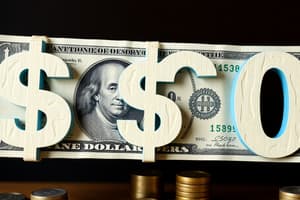Podcast
Questions and Answers
What is the correlation between money growth and inflation according to the provided information?
What is the correlation between money growth and inflation according to the provided information?
- 0.80
- 0.50
- 0.60
- 0.70 (correct)
Which country is noted for having low money growth and, consequently, low inflation?
Which country is noted for having low money growth and, consequently, low inflation?
- Mozambique
- Japan (correct)
- Ghana
- Zimbabwe
What is referred to as seigniorage?
What is referred to as seigniorage?
- The revenue from printing money (correct)
- The interest earned on government bonds
- Revenue raised from taxes
- The tax on holders of money
Which of the following methods is NOT a way for a government to finance its spending?
Which of the following methods is NOT a way for a government to finance its spending?
When a government prints money to finance its expenditures, which of the following is a consequence?
When a government prints money to finance its expenditures, which of the following is a consequence?
What effect does inflation have on the real value of money held by individuals?
What effect does inflation have on the real value of money held by individuals?
What is the 'inflation tax' similar to?
What is the 'inflation tax' similar to?
Which of the following is an example of a country with high money growth?
Which of the following is an example of a country with high money growth?
How does higher income affect the demand for real money balances?
How does higher income affect the demand for real money balances?
What does the relationship V = 1/K indicate about money demand and velocity?
What does the relationship V = 1/K indicate about money demand and velocity?
According to the quantity equation, what is the role of velocity (V)?
According to the quantity equation, what is the role of velocity (V)?
What assumption is made in the quantity theory of money for it to be considered useful?
What assumption is made in the quantity theory of money for it to be considered useful?
What is implied when the money demand parameter k is large?
What is implied when the money demand parameter k is large?
What does the quantity equation M × V = P × Y express?
What does the quantity equation M × V = P × Y express?
How can k and V be characterized in terms of their relationship?
How can k and V be characterized in terms of their relationship?
In the context of money demand, what does a small k suggest?
In the context of money demand, what does a small k suggest?
What is the effect of an expected increase in the money supply on today's price level?
What is the effect of an expected increase in the money supply on today's price level?
Which statement best describes the Fisher effect?
Which statement best describes the Fisher effect?
What does the equation $M = L(r + E \pi, Y)$ represent?
What does the equation $M = L(r + E \pi, Y)$ represent?
Which variable in the context of the given equations is considered exogenous?
Which variable in the context of the given equations is considered exogenous?
What does an increase in the rate of money growth by 1 percent cause in terms of inflation rate?
What does an increase in the rate of money growth by 1 percent cause in terms of inflation rate?
What is the relationship articulated by the Fisher effect?
What is the relationship articulated by the Fisher effect?
What does the transaction velocity of money (V) measure?
What does the transaction velocity of money (V) measure?
How is the total number of dollars exchanged in a year calculated?
How is the total number of dollars exchanged in a year calculated?
If the total transactions equal $100 and the money supply is $20, what is the velocity of money?
If the total transactions equal $100 and the money supply is $20, what is the velocity of money?
Flashcards
Money Demand
Money Demand
The amount of money that people want to hold in relation to their income.
Velocity of Money
Velocity of Money
The average number of times a dollar is spent on goods and services in a period of time.
Quantity Equation
Quantity Equation
A simple equation showing the relationship between money supply, velocity, price level, and real output.
Connection Between Money Demand and Velocity
Connection Between Money Demand and Velocity
Signup and view all the flashcards
Constant Velocity Assumption
Constant Velocity Assumption
Signup and view all the flashcards
Quantity Theory of Money
Quantity Theory of Money
Signup and view all the flashcards
Money Demand and Income
Money Demand and Income
Signup and view all the flashcards
Velocity as a Ratio
Velocity as a Ratio
Signup and view all the flashcards
Seigniorage
Seigniorage
Signup and view all the flashcards
Inflation Tax
Inflation Tax
Signup and view all the flashcards
Inflation
Inflation
Signup and view all the flashcards
Money Growth
Money Growth
Signup and view all the flashcards
Link between money growth and inflation
Link between money growth and inflation
Signup and view all the flashcards
Government Finance
Government Finance
Signup and view all the flashcards
Printing Money to Finance Expenditure
Printing Money to Finance Expenditure
Signup and view all the flashcards
Financing Government Spending
Financing Government Spending
Signup and view all the flashcards
Total Dollar Value of Transactions
Total Dollar Value of Transactions
Signup and view all the flashcards
Money Supply (M)
Money Supply (M)
Signup and view all the flashcards
Nominal GDP
Nominal GDP
Signup and view all the flashcards
Number of Transactions (T)
Number of Transactions (T)
Signup and view all the flashcards
Price Level (P)
Price Level (P)
Signup and view all the flashcards
Total Value of Transactions (P * T)
Total Value of Transactions (P * T)
Signup and view all the flashcards
Fisher Equation
Fisher Equation
Signup and view all the flashcards
Fisher Effect
Fisher Effect
Signup and view all the flashcards
Real Interest Rate
Real Interest Rate
Signup and view all the flashcards
Nominal Interest Rate
Nominal Interest Rate
Signup and view all the flashcards
Relationship between Inflation and Nominal Interest Rates
Relationship between Inflation and Nominal Interest Rates
Signup and view all the flashcards
Fisher Effect in the U.S.
Fisher Effect in the U.S.
Signup and view all the flashcards
Fisher Effect across Countries
Fisher Effect across Countries
Signup and view all the flashcards
Money Market Equilibrium
Money Market Equilibrium
Signup and view all the flashcards
Exogenous Money Supply
Exogenous Money Supply
Signup and view all the flashcards
Real Interest Rate Adjustment
Real Interest Rate Adjustment
Signup and view all the flashcards
Output Determined by Production Factors
Output Determined by Production Factors
Signup and view all the flashcards
Price Level Adjustment
Price Level Adjustment
Signup and view all the flashcards
Expected Inflation's Impact on Price Level
Expected Inflation's Impact on Price Level
Signup and view all the flashcards
Higher Nominal Interest Rates and Money Demand
Higher Nominal Interest Rates and Money Demand
Signup and view all the flashcards
Quantity Theory of Money: Expanded Version
Quantity Theory of Money: Expanded Version
Signup and view all the flashcards
Quantity Theory of Money: Simple Version
Quantity Theory of Money: Simple Version
Signup and view all the flashcards
Long-Run Inflation Expectations
Long-Run Inflation Expectations
Signup and view all the flashcards
Neutrality of Money
Neutrality of Money
Signup and view all the flashcards
Impact of Expected Inflation on Price Level
Impact of Expected Inflation on Price Level
Signup and view all the flashcards
Study Notes
Inflation: Causes, Effects, and Social Costs
- Inflation is the increase in the overall level of prices over time in most modern economies.
- Economists measure inflation rates using the percentage change in the Consumer Price Index (CPI) and the GDP deflator.
- Deflation is a period when most prices fall, a phenomenon that occurred in the 19th century.
- Hyperinflation is an extraordinarily high rate of inflation, as observed in Germany in 1923, Zimbabwe in 2008, and Venezuela in 2017, where average monthly price increases were very significant.
- A classical theory of inflation assumes flexible prices and market clearing; it describes long-run economic behavior and is useful for understanding inflation in the short run, assuming short-run price stickiness is ignored.
The Quantity Theory of Money
- The quantity of money in an economy is related to the number of dollars exchanged in transactions.
- Money is held to buy goods and services, directly implying the more money needed for transactions, the more held.
- The quantity equation is represented as: Money x Velocity = Price x Transactions (M x V = P x T)
- T refers to the total number of transactions during a set time period (like a year); it signifies how many times goods/services are exchanged for money.
- P represents the typical transaction price, or the number of dollars exchanged in a transaction.
- M is the quantity of money.
- V (Velocity) measures how quickly money moves through the economy. It indicates the number of times a dollar changes hands in a specific time period.
- The quantity equation can be rewritten as (using Y instead of T to represent total output, representing transactions): M x V = P x Y
From Transactions to Income
- The quantity equation is modified for practical measurement by using nominal GDP (Y) as a proxy for total transactions instead of T.
- The modified equation is: V x M = P x Y, where Y represents the total output of the economy.
Money Demand and the Quantity Equation
- Real money balances measure the purchasing power of the money supply (M/P).
- A simple money demand function is written as (M/P)d = k * Y.
- K represents the amount of money people wish to hold for each dollar of income in the respective economy (exogenous).
- Real money balances desired are proportional to real income, in other words, the more income, the more money desired.
- The Velocity of Money (V) and the money demand parameter (K) can be related as V=1/K.
- The greater K, the lower V, less frequently money changes hands, and Vice-versa.
The Quantity Theory of Money (cont'd)
- With constant velocity (V), the money supply determines nominal GDP.
- Real GDP is determined by factors of production and the relevant production function.
- The price level is calculated as Nominal GDP / Real GDP.
- Assuming constant velocity, the quantity theory of money implies that the price level is proportional to the money supply.
- Inflation rate is calculated by: π = (ΔM/M) − (ΔY/Y) where (△M/M) is the growth rate of money and (△Y/Y) is the growth rate of output.
Seigniorage
- Seigniorage is the revenue raised from printing money by a government.
- Inflation, which arises from increasing the money supply, is analogous to a tax on holding money
- Countries with high money growth will likely have higher inflation rates in the long run.
Inflation and Interest Rates
- Real interest rates are adjusted for inflation.
- Nominal interest rate (i) = Real Interest rate (r) + Inflation rate (π)
- The Fisher equation shows the relationship between the real interest rate, inflation rate, and nominal interest rate (i = r + π).
Money Demand and Nominal Interest Rates
-
In the quantity theory of money, the demand of real money balances depends only on real income (Y).
-
The nominal interest rate also impacts money demand.
-
The nominal interest rate is the opportunity cost of holding money rather than bonds.
Equilibrium
-
Equilibrium occurs when the supply of real money balances equals the demand for real money balances; M/P = L(i, Y)
-
The money supply (M) is determined exogenously by the Fed.
-
Real income (Y) is determined by the factors of production and technology.
-
Real interest rate (r) adjusts to ensure savings equals investment.
-
Other conclusions from these relationships can be found within the respective pages for more context.
Studying That Suits You
Use AI to generate personalized quizzes and flashcards to suit your learning preferences.
Related Documents
Description
This quiz covers essential concepts related to inflation, including its causes, effects, and the social costs associated with it. It also delves into the Quantity Theory of Money, explaining the relationship between the money supply and economic transactions. Test your understanding of these fundamental economic principles.



